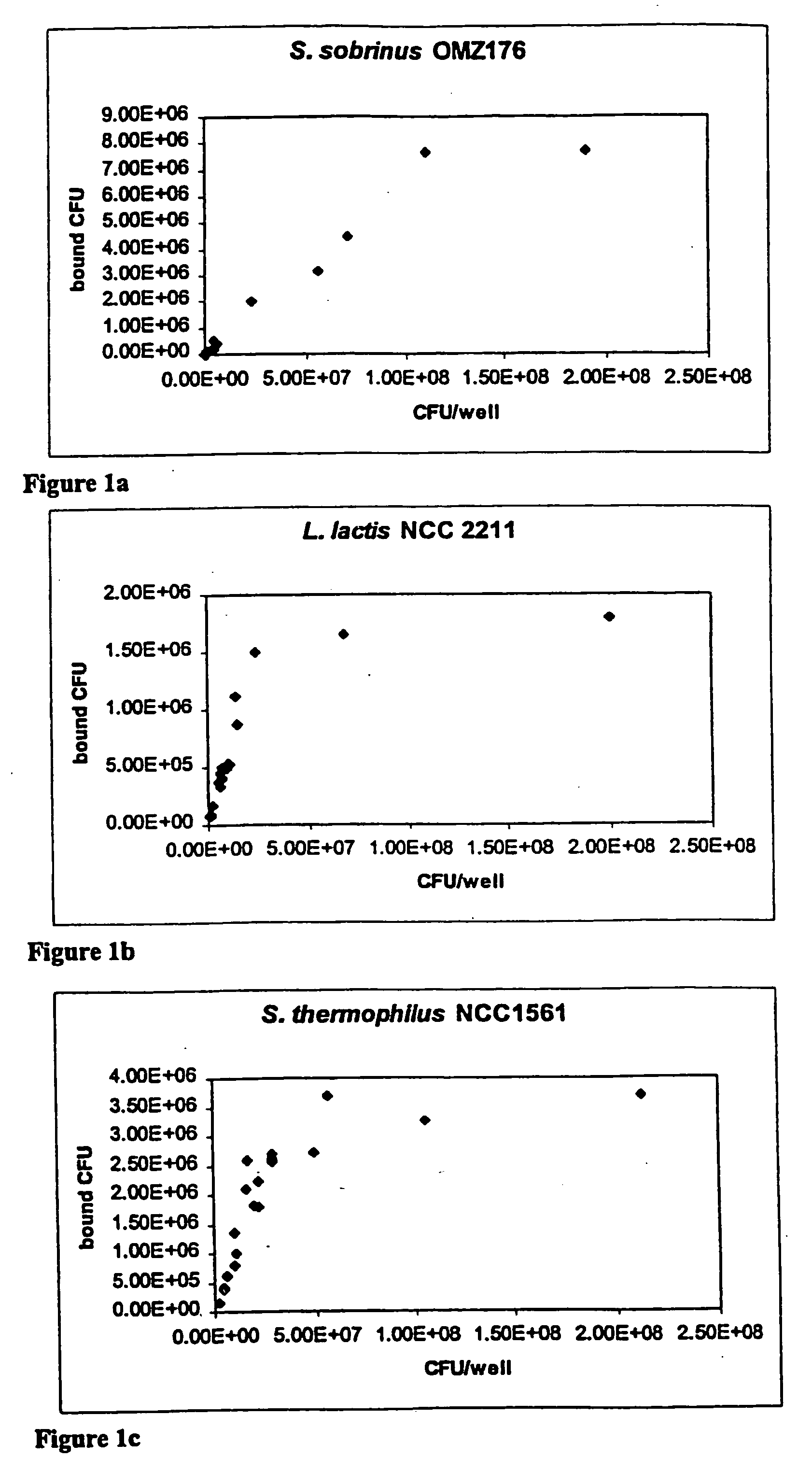Treatment of Actinomyces naeslundii-related diseases with exogenous lactic bacteria strains
a technology actinomyces naeslundii, which is applied in the field of treating actinomyces naeslundiirelated diseases with exogenous lactic bacteria strains, can solve the problems of lactic bacteria that are not part of the resident microflora of the mouth, cannot directly adhere to the pellicle of teeth, and cannot achieve direct adhesion of exogenous lactic bacteria, so as to enhan
- Summary
- Abstract
- Description
- Claims
- Application Information
AI Technical Summary
Benefits of technology
Problems solved by technology
Method used
Image
Examples
example 1
Strains and Culture Conditions
More than 100 strains (belonging to the Nestle culture collection) were screened for their ability to attach to saliva-coated hydroxyapatite beads, and in particular the following 23 strains: S. thermophilus Y54 (NCC 2284), S. thermophilus 5fi6 (NCC 1971), S. thermophilus Sfi13 (NCC 2008), S. thermophilus Sfi21 (NCC 2038), S. thermophilus Sfi39 (NCC 2130), S. thermophilus Sfi42 (NCC 2145), S. thermophilus Sfi47 (NCC 2172), S. thermophilus S118 (NCC 1529), S. thermophilus S119 (NCC 1536), S. thermophilus S122 (NCC 1554), S. thermophilus S123 (NCC 1561), S. thermophilus S126 (NCC 1587), L. lactis subsp. cremoris 15 (NCC 92), L. lactis subsp. cremoris 25 (NCC 1932), L. lactis subsp. cremoris 136 (NCC 2419), L. lactis subsp. diacetylaclis 8 (NCC 1970), L. lactis subsp. diacetylactis 28 (NCC 2057), L. lactis ssubsp. diacetylactis 69 (NCC 2225), L. lactis subsp. diacetylactis 80 (NCC 2272), L. lactis subsp. lactis 29 (NCC 2211), L. lactis subsp. lactis 50 (...
example 2
Production of Monoclonal Antibody
A monoclonal antibody would be used as a tool to detect L. lactis subsp. lactis NCC22111 among 5 oral strains growing together on S-HA discs and forming a biofilm that simulates dental plaque. Therefore the monoclonal antibody was tested against these strains to verify there was no cross-reaction. To this end, the monoclonal antibody is produced as described by Granato et al. “A mouse monoclonal IgE antibody anti-bovine milk lactoglobulin allows studies of allergy in the gastrointestinal tract., Clin. Exp. Immunol., 63, 703-710, 1986.
example 3
Selection of Adherent Lactic Bacteria
Attachment to saliva-coated hydroxyapatite beads (S-HA)
To select among the lactic bacteria dairy strains those strains that are able to attach to saliva-coated hydroxyapatite beads (S-HA), the procedure previously described by Neeser et al. (1994) was used with slight modification in that the bead washings were done with 150 μl volumes and Hyamine hydroxide was substituted with Benzethonium hydroxide (Sigma).
Briefly, all the strains were grown to the end of the log phase in FUM except S. thermophilus NCC1529, S119, S122, NCC1561, and S126 that were cultured in Belliker. S. sobrinus OMZ 176, L. lactis subsp. lactis NCC2211, 50 and 54, S. thermophilus NCC1529, S119, S122, NCC1561, and S126 grew at 37 C°, the remaining lactococci at 30° C., and the remaining streptococci at 42° C.
5 mg of hydroxyapatite beads (BDH Chemicals Ltd, Poole, England) were covered with 70 μl clarified saliva obtained from volunteers in the lab and prepared as previo...
PUM
| Property | Measurement | Unit |
|---|---|---|
| thick | aaaaa | aaaaa |
| temperature | aaaaa | aaaaa |
| temperature | aaaaa | aaaaa |
Abstract
Description
Claims
Application Information
 Login to View More
Login to View More - R&D
- Intellectual Property
- Life Sciences
- Materials
- Tech Scout
- Unparalleled Data Quality
- Higher Quality Content
- 60% Fewer Hallucinations
Browse by: Latest US Patents, China's latest patents, Technical Efficacy Thesaurus, Application Domain, Technology Topic, Popular Technical Reports.
© 2025 PatSnap. All rights reserved.Legal|Privacy policy|Modern Slavery Act Transparency Statement|Sitemap|About US| Contact US: help@patsnap.com


